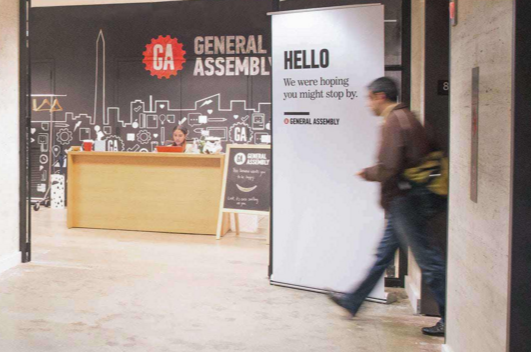Almost 23,000 Americans graduated from code schools last year, a more than 900 percent increase since 2012, according to Course Report, a company that studies trends and attendance at nearly 100 code schools across the U.S.
Also known as bootcamps, code schools are typically three-to-six-month programs that usually bill themselves as the way to help lower-income workers and people from outside the technology sector find jobs in tech — minus the expensive, four-year computer science degree. Web development as self improvement.
In D.C., the same upward trajectory of code school growth and participation is playing out. Coding Dojo, which established an office in McLean, Va., in summer 2016, rolled out a new Java coding course last summer. Earlier this month, the New York–based Flatiron School, recently acquired by coworking giant WeWork, announced classes would begin at its new WeWork White House classrooms on G Street in March. The $9.6 million funding round announced several weeks ago by online-only coding program Thinkful coincided with its one-year anniversary of establishing an IRL networking presence in the District, where Thinkful employees set up events for students to meet one another and prospective employers.
“We’re doing a lot more in-person events,” says Thinkful CEO Darrell Silver. “Our employees reach out to companies and talk up the grads and figure out what companies’ hiring pipelines are.”
Add into the mix General Assembly, which got its start in D.C. in 2013. The global organization started in 2011 as a coworking space that hosted coding classes, before getting out of coworking entirely and going all-in on the bootcamp model by the time it reached the District. “It was really just driven by need,” says D.C. regional director Shanaz Chowdhery. “There was a significant number of people who were craving skills-based education.”

At General Assembly’s D.C. campus. (Courtesy photo)
The growth in code schools coincides with a notion of “blue-collar coding,” a term coined by Anil Dash in 2012 that has taken some years to actually catch on. Now it’s not hard to find advocates of coding education who view it as a way to drive economic growth. Last September, Apple CEO Tim Cook took the stage at the first Bloomberg Global Business Forum and said, “Where manufacturing was key to the middle class years ago, coding is key to the middle class today and tomorrow.” That happened after Wired’s Clive Thompson asked what might happen if we imagined coders were “the equivalent of skilled workers in a Chrysler plant.”
Jobs reports seem to back up the fervor. A recent survey by Indeed found that, among tech recruiters and hiring managers, nine out of 10 thinking finding and hiring tech talent is challenging, even at a time when tech jobs are rapidly proliferating. That same Indeed survey found that the top five jobs of 2017, according to its data, were all in technology fields; the top job was full-stack developer. Some figures estimate the number of tech jobs nationwide to be as high as 500,000, a tall order for the roughly 43,000 annual computer science graduates to fill.
According to Course Report, roughly 80 percent of code school graduates are able to lock down work in the tech sector within six months, with an average salary of $70,000 — more than enough to pay back the $10,000 to $20,000 that most code schools typically cost.
And yet code schools remain a new kind of system, one still working through the potential pitfalls. A long article published by Bloomberg Businessweek in December 2016 catalogued a number of students who had paid primo prices for programming training attached to the hope of a high-paying job at the end. Last year, the nationwide campuses of Dev Bootcamp and the Iron Yard — the latter of which had a D.C. location — abruptly shut down. Course Report found that while 15 new code schools opened in 2017, another seven closed.
“Coding schools need to adapt to new methods, definitely,” says Liz Eggleston, cofounder of Course Report. “The schools I see being most successful are close with their employer networks, and ones that iterate in each cohort based on what employers are asking for.”
Thinkful, the Flatiron School and General Assembly are trying to build more of those relationships in the District. It’s the reason why an online-only school like Thinkful hires D.C.-based employees, why the Flatiron School sets up shop within a coworking space with a pre-existing community of technologists and startups, and why General Assembly sponsors field trips for students to local employers.
Schools with robust employer networks that iterate in each cohort, as Eggleston says, means they can tailor their course curricula to employer needs.
“We work with employers on what they need today and what they need in the future,” GA’s Chowdhery says. “We structure our curriculum to make sure it’s in line with the demands of the market.”
These sorts of community roots can be powerful allies for code schools. Not only are they a way to demonstrate real-world relevance to students, but they’re also necessary, it seems, for a school to succeed. Launch Academy, a Boston-based coding program, was set to launch a women-only program in D.C. in the fall only to backtrack on that decision because of a lack of interest, DC Inno reported.
The schools I see being most successful are close with their employer networks, and ones that iterate in each cohort based on what employers are asking for.
But there is a further risk in relying on non-CS majors now slinging JavaScript and other programming languages in technical positions. Remaking the middle-class communities of America via code, as Apple’s Cook would seem to have it, could mean that anyone trained today will be out of a job tomorrow.
“We’re expecting code schools to do too much,” says Mike Subelsky, a veteran programmer and startup founder in Baltimore who experimented with running his own in-startup code school several years ago. “Experience is what makes you a good programmer, and after three months, you really just have the basic syntax of the language down. Any nontrivial application is going to need at least two or three other skills.”
In other words: Thinking like a programmer is more important than simply gaining the practical skills that come with learning a programming language.
More support for teaching students the conceptual underpinnings of computer science is something that code schools are increasingly figuring out and building into their programs, Course Report’s Eggleston says. Three years ago the average bootcamp was 10 weeks long; today, it’s 14 weeks long. Those extra weeks are time for would-be coders to learn skills and concepts that employers are looking for.
Several of the code schools set up in D.C. also provide introductory courses online to slowly bring a person into coding before tossing them into an immersive program. General Assembly’s free “Dash” course teaches people rudimentary HTML, CSS, and JavaScript for web development, while the Flatiron School offers free introductory courses to JavaScript and Ruby.

A coding demo at a Thinkful event in D.C. (Courtesy photo)
The flexibility of code schools — with curriculum and scheduling — is why Adam Enbar, CEO of the Flatiron School, believes so strongly in their model.
“The jobs we have today won’t exist in 10 years,” he says. “We have to make education part of our careers and part of our lives.”
What’s more, building coding education into people’s careers appears to have the added benefit of diversifying the tech sector. A full 40 percent of graduates from code schools nationwide are women, a number that’s growing, according to Course Report. And because code schools can be nimble in how, and how often, they offer coding courses, they can be an avenue for reaching potential programmers at the lower end of the socioeconomic spectrum who can’t afford to drop a full-time job in order to study computer programming full-time.
Thinkful, for example, offers online-only, one-on-one courses for such students: people who need to go at their own pace and schedule a coding education around their work obligations.
“The challenge that bootcamps are trying to solve is career growth. Meanwhile, employers have career demands,” Thinkful’s Silver says. “But when you are forced to quit your job, you filter the world through the people who can quit a job.”
While code schools might still be tweaking with their models, their proponents argue they’re able to fall back on a key selling point: The skills they’re teaching could very well lead to a better job, with a higher income, in technology — and at a fraction of the cost and time of traditional four-year universities.
“I think the days of ‘Go learn for four years and work the rest of your life’ are just over,” says Flatiron’s Enbar. “What does the future of working look like? Education, by necessity, has to be a part of it.”
Before you go...
Please consider supporting Technical.ly to keep our independent journalism strong. Unlike most business-focused media outlets, we don’t have a paywall. Instead, we count on your personal and organizational support.
Join our growing Slack community
Join 5,000 tech professionals and entrepreneurs in our community Slack today!

Entrepreneurship is changing, and so is the economic development behind it

Tech Hubs’ new $210M funding leaves Baltimore and Philly off the table

Here’s what to know before using AI to craft your brand’s social media posts

